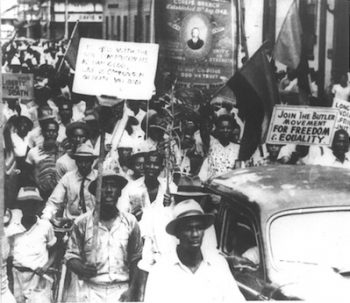This year, on 19 June, Trinidad celebrates 50 years of Labour Day (first marked in 1973). The roots of this occasion, however, can actually be traced 36 years earlier to one of the most outstanding events in Trinidadian history – the 1937 general strike.
For decades prior, the Trinidadian working class had been growing in number and militancy. The booming oil industry swelled the ranks of the proletariat with those seeking better pay and conditions from the sugar and cocoa plantations.
The class battles on the island set an inspiring example to the working class throughout the Caribbean, which led to strike waves on every island in the 1930s.
The lessons from the general strike must be absorbed by the working class and their leadership ahead of coming stormy events in world politics, which bear some resemblance to the situation in the 1930s.
In 1970, the so-called Black Power Revolution could have toppled the government and abolished capitalism. However, the revolution’s leadership had failed to fully digest the lessons of 1937, leading to defeat.
The conditions for socialist revolution in Trinidad and on an international scale have never been so favourable. If the mistakes of the past are not to be repeated, a balance sheet must be drawn from history.
Sugar, oil, and blood
Just as the Atlantic slave trade had transformed Trinidad into a sugar colony, the abolition of slavery transformed it even further. Under indentured servitude, Indian ‘coolies’ were brought by the British to Trinidad from 1845 onwards.
Struggling to replace the labour force following the withdrawal of black former slaves, and facing competition from other sugar-producing nations, the plantation owners used indentured servants from India who were paid extremely low wages in order to keep the plantations profitable.
Some skilled black former slaves remained in the sugar factories as carpenters, masons, boiler-men, and factory operators. As a result of migration into the country, between 1851 and 1891 the population increased from 68,600 to 200,028.
However, the sugar industry went into decline in Trinidad in the 1890s, but the booming cocoa industry offset a more serious economic depression. In Tobago, the dominance of the sugar industry effectively ended in the 1890s due to the collapse of the British firm Gillespie & Co.
Oil was discovered in Trinidad around 1857, and by 1900 major oil fields were drilled and became a source of huge profits. This offset the worst of the economic decline of the sugar industry but conditions were still miserable for workers and peasants.
In 1897, a Royal Commission was sent from Britain to examine the seriousness of the sugar collapse and recommend solutions to the problem.
Water riots 1903
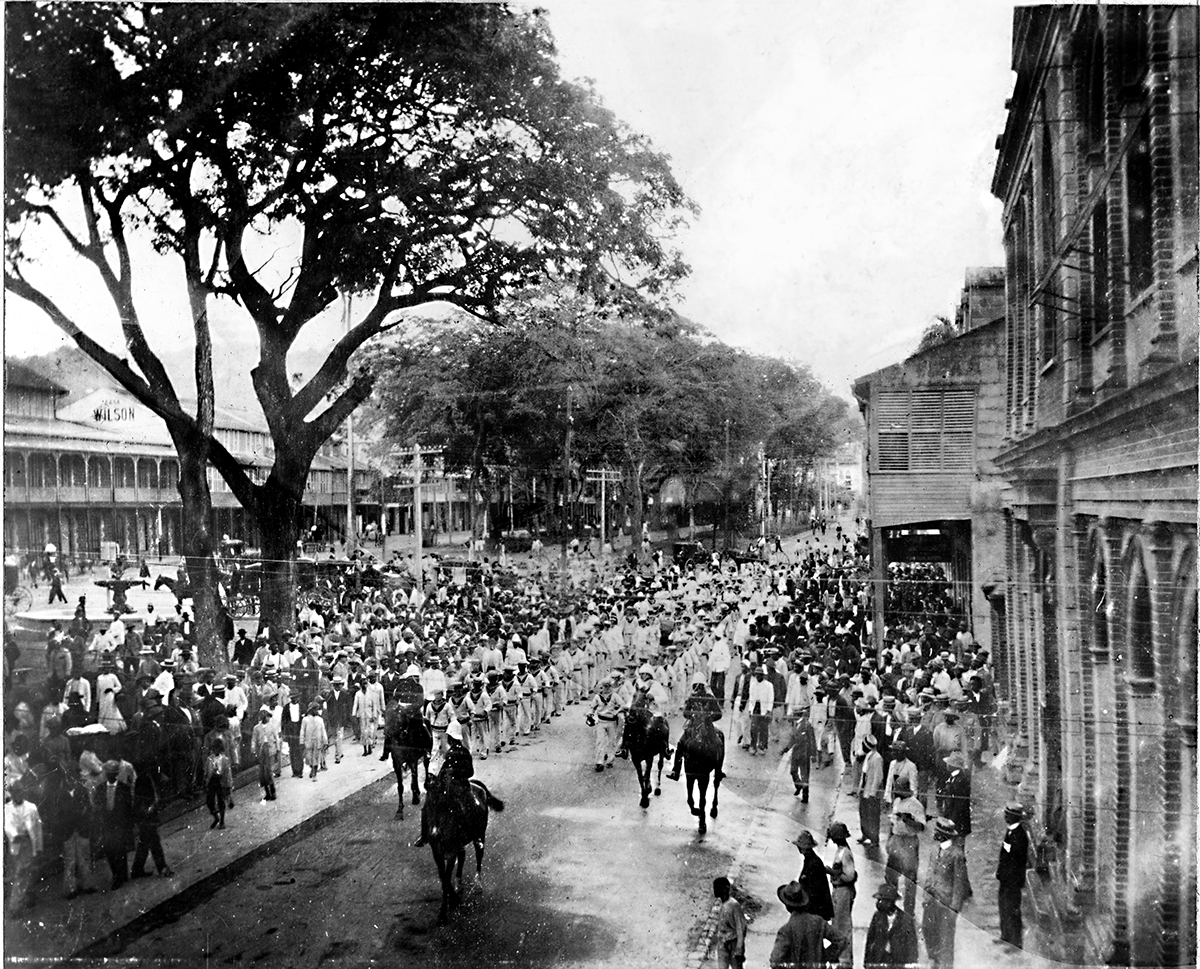 In 1902, proposed new rates and water meters by the government to combat water wastage were the sparks that lit the fuse / Image: public domain
In 1902, proposed new rates and water meters by the government to combat water wastage were the sparks that lit the fuse / Image: public domain
At the time, Trinidad & Tobago was a Crown Colony, which was run by a Governor appointed by the British monarch and an advisory body called the Legislative Council. White merchants and planters had petitioned the Colonial Office since the early 1900s for an elective institution, and by the late 1800s a sizable group of mulatto (mixed race) and black professional men joined the agitation for an elective institution of government.
The boom of the cocoa industry and the beginnings of an oil industry had led to, on the one hand, a growing petty bourgeoisie, and on the other hand, a larger working class.
Without any form of democratic political expression, a group of political agitators from the petty-bourgeois and working-class set up the Trinidadian Workingmen’s Association (TWA) in 1897. It was the first labour organisation in the British Caribbean and it pressured the visiting Royal Commission for political and economic changes.
The president of the TWA, Walter Mills, petitioned for lower taxes, land reforms, and most importantly an elective institution. These demands were mainly ignored by the authorities, only adding to the pressure from below.
In 1902, proposed new rates and water meters by the government to combat water wastage were the sparks that lit the fuse. The government accused the people of wasting water, which was seen as a luxury in the hot climate. Angered by the accusation, workers came out onto the streets and turned these accusations back on the rich.
On 23 March 1903, a meeting of government officials at the Red House (the main government administration building) was surrounded by thousands of protestors. The police protecting the building and officials clashed with protestors, which led to a riot in which the Red House was burnt down, amidst police shooting and even bayonetting protestors. In all, 18 were killed and 42 wounded.
Only minor concessions were granted in the aftermath of the massacre. While an elective institution was introduced, this was only a local assembly, set up 10 years after the fact, with extremely limited powers.
The ranks of the TWA swelled during the 1910s and it could count several thousand workers as members. It also built links with the newly founded British Labour Party. For example, Labour MP for Attercliffe in Sheffield, Joseph Pointer, actually visited Trinidad in 1912 to help build the organisation as well as campaign for a change of the colony’s form of government.
By this point, a number of Indo-Trinidadians whom Pointer had encouraged to participate in the struggle had joined the calls for reform. However, the TWA was showing signs of a split over the question of how best to win their demands.
In contrast to the established, reformist wing, an impatient radical wing led by J. Sydney de Bourg had developed. In July 1914, de Bourg’s faction saw its opportunity to take over the TWA. They successfully ousted the reformists with support from the membership who had grown tired of ‘respectable’ agitation.
However, the outbreak of WWI cut across the growing revolutionary mood on the island, and the possibility of constitutional reform was temporarily shelved.
1919 strike wave
During WWI, small strikes on the island continued. For example, oil and asphalt workers at companies in Fyzabad and Point Fortin went out on strike after their request for a wage increase was refused. They decided on five-day stoppages in February 1917.
During the same month, the Trinidad Lake Asphalt Company's sheds were set on fire. Soldiers were deployed to put down the strikes and five of the strike leaders were arrested, with three being sentenced to hard labour.
A number of black soldiers in the colony were used against the strikes. They were members of Trinidad's contingent to the British West India Regiment who had not yet been sent to the frontlines in Europe.
However, black soldiers who had fought in Europe returned radicalised by their experience of imperialist war, as well as the racial discrimination they suffered on their return. As a result of the war’s disruption to world trade, inflation reached a staggering 145 percent by 1919, only adding more fuel to the fire.
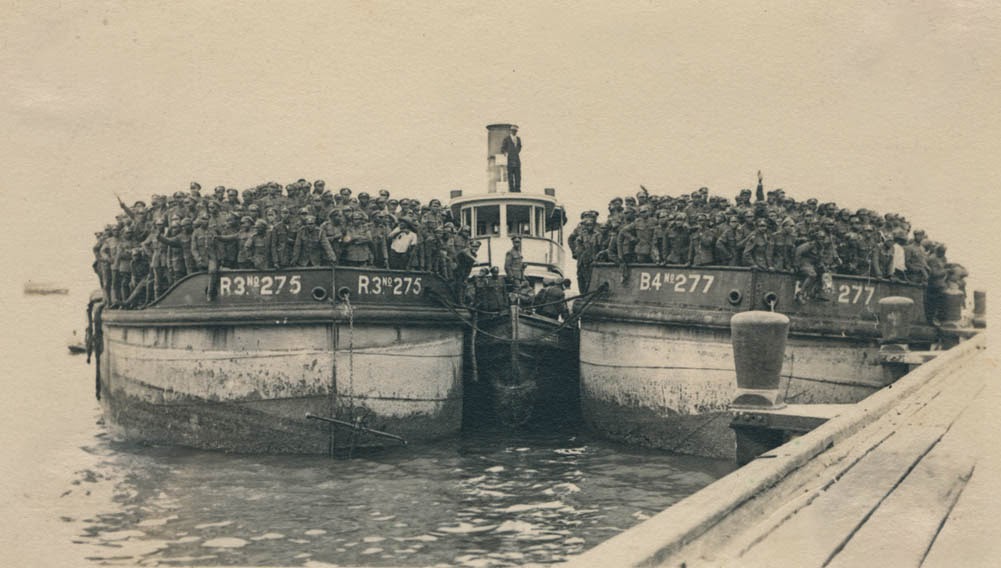 Black soldiers who had fought in Europe returned radicalised by their experience of imperialist war / Image: public domain
Black soldiers who had fought in Europe returned radicalised by their experience of imperialist war / Image: public domain
As such, large numbers of militant ex-servicemen joined the TWA as strikes began to break out at the end of the war. The TWA, under new leadership, eventually came out in support of the growing strike wave in response to government suppression of a strike by railwaymen and dock workers during March 1919.
Dock workers demanded increased wages, overtime pay, and an eight-hour working day. On 1 December, they chased their replacements from the waterfront and won a 25 percent wage increase. The victory caused the strike wave to spread from the docks of Port of Spain across the country, including rural labourers on sugar plantations.
The whole island, including Tobago, was effectively out on strike. In response, British troops were sent and the government passed laws against sedition, strikes, and protests in order to hamper the efforts of the TWA and snuff out the workers’ movement.
Undeterred and having tasted victory on the industrial front, the agitation for political demands and social reforms was ramped up, and a number of concessions were granted.
For instance, the Legislative Council was expanded to include six functionaries nominated by the Governor, seven elected functionaries, 12 officials and the Governor. Thus, the elected members were in the minority. The franchise was also extended to women over 30 and men over 21 years of age, with specific property and income qualifications.
The TWA framed these concessions as a decisive victory and encouraged the striking workers to return to work, and use this opportunity to achieve their aims through constitutional means.
As demonstrated time and again throughout history, the movement for national and social liberation cannot be entrusted to the national bourgeoisie, but can only come from a mass movement of the working class and peasantry under revolutionary socialist leadership.
Cipriani and the TWA
In 1923, Arthur Cipriani became the leader of the TWA. Cipriani was a former military captain of Corsican descent who recruited soldiers in Trinidad for WWI. On his return from the war, in an interview he spoke of "the contempt, humiliation, insults and suffering heaped upon the men of the British West Indies".
He threw himself into recruiting ex-servicemen into the TWA and quickly earned the respect of the rank-and-file as an ardent fighter for their cause.
In the first elections to the Legislative Council in 1925, the TWA won 3 of the 7 seats available. And in 1928, they won 4 of the 7 seats. Cipriani, as an elected member of the Council, agitated for better pay and conditions for workers. However, he made many mistakes, such as signing legislation that set the minimum wage below that of the existing wages.
He limited the TWA and workers’ movement to pursue constitutional reforms. Unfortunately, he was a reformist politically, and under his leadership, he sowed illusions in the constitutional route to change, which dampened the movement throughout the 1920s.
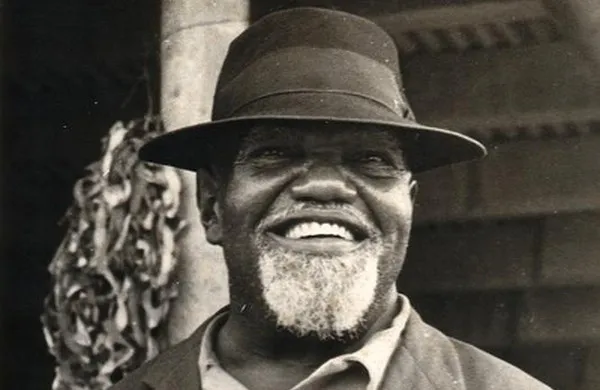 New trade union leaders emerged by the 1930s, most notably Tubal Uriah ‘Buzz’ Butler and Adrien Cola Rienzi / Image: public domain
New trade union leaders emerged by the 1930s, most notably Tubal Uriah ‘Buzz’ Butler and Adrien Cola Rienzi / Image: public domain
However, new trade union leaders emerged by the 1930s, most notably Tubal Uriah ‘Buzz’ Butler and Adrien Cola Rienzi.
Butler had fought in WWI and participated in the Grenadian labour movement before moving to Trinidad in 1921 to work in the oilfields. He represented the most militant wing of the working class, openly demanding an end to the Crown Colony system and the exploitation of the working class.
Rienzi (born Krishna Deonarine) was a Trinidadian lawyer of Indian heritage who had studied in England and Ireland. In London, he had worked alongside Shapurji Saklatvala, Communist Party of Great Britain MP for Battersea, before returning to Trinidad in 1934.
Cipriani, Butler, and Rienzi, represented the whites and mulattoes, black, and Indian masses, respectively. But vitally together they could rally the masses as a whole on a class basis.
Great Depression
The 1920s saw US imperialism reap huge profits from the oil industry. However, the 1929 Crash and Great Depression massively disrupted world trade and markets. As a large exporter of sugar and oil, Trinidad was not immune from the economic crisis and unemployment began to rise.
The workers were on the move once again in response to the attacks by employers on wages and conditions.
In July 1930, 2,000 armed labourers marched on Port of Spain and demanded that the plantation owners and the government withdraw wage cuts and abolish the increased hours. The armed demonstrators refused to return to work until their demands were met and this inspired further unrest on other plantations.
The plantations were employing child labourers for 5 to 7 pence per day to avoid paying adults 1/6 to 2/- per day (one shilling and sixpence (18p) to two shillings (24p)).
In 1931, Trinidadian Marxist George Padmore outlined in ‘Imperialism in the West Indies’ the conditions that workers on the plantations and docks faced:
“...[T]here is a big oil and asphalt industry, an industrial proletariat has been brought into being in recent years. Thousands of Negroes are employed to dig the pitch (asphalt) and to load ships at La Brea, at an average of 50 cents per day and live under terrible conditions.”
He went on to offer the following solution:
“The workers and peasants in the West Indies must build up a real revolutionary trade union movement. For example in Trinidad where the labour movement has reached the most advanced stage, the left wing opposition to the reformists misleaders, (Cipriani and Bishop who presently control the Working Men’s Association) should immediately begin a wide campaign among the rank and file in the various unions, as well as the unorganized on the basis of concrete everyday demands which should be linked up with the ultimate demands of the class interests, to win the masses away from the reformists and develop the left wing movement. Rank and file committees should be set up inside and outside the unions.”
In other words, the working class and their leadership must begin the formation of an organised revolutionary tendency. This represented a major step forward.
The colonial regime grew increasingly nervous about this explosive situation erupting to the surface, and took efforts to clamp down on dissent. For example, The Negro Worker journal published by the Stalinist Comintern was banned in April 1932.
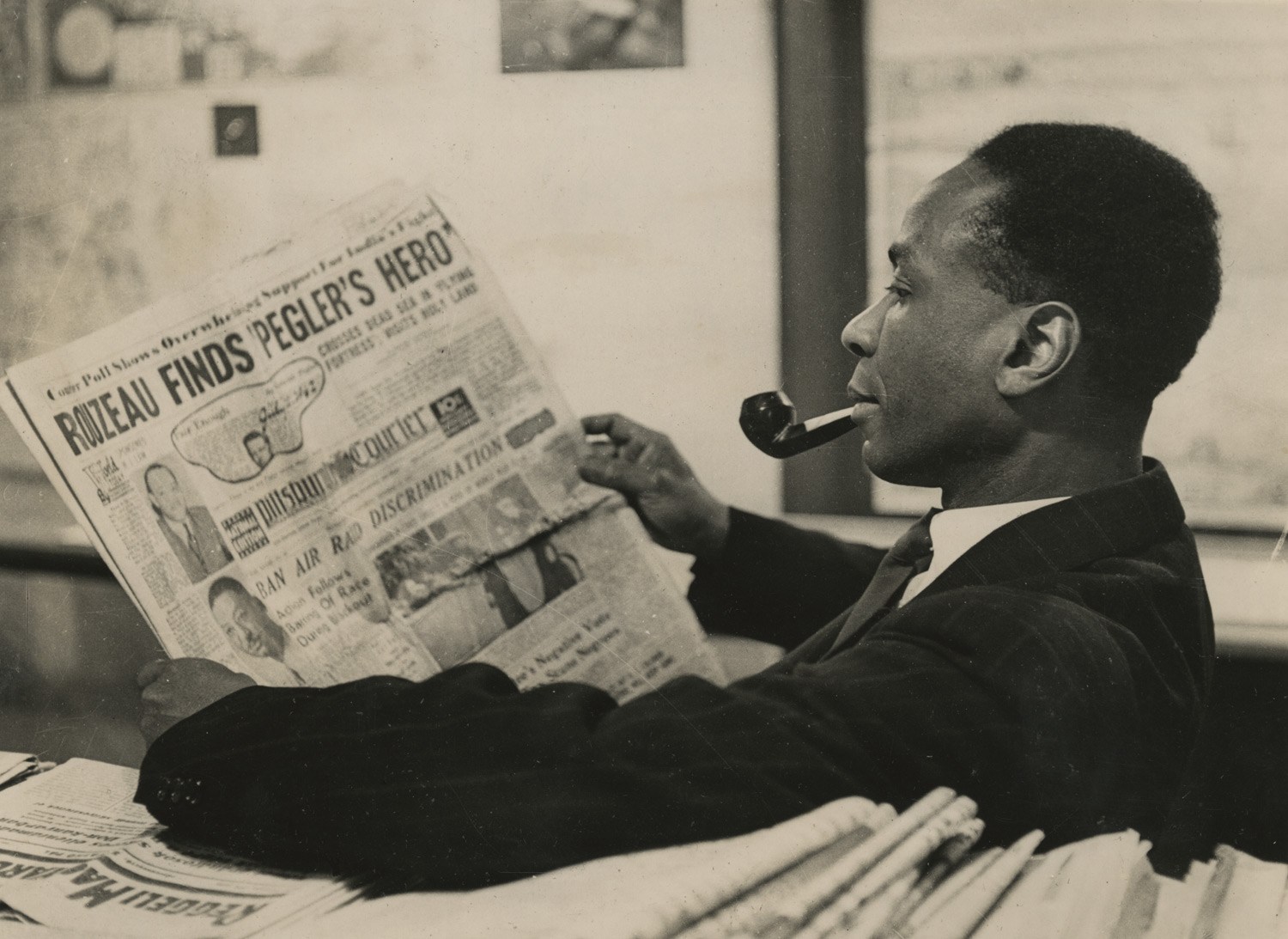 Trinidadian Marxist George Padmore outlined the conditions that workers on the plantations and docks faced / Image: public domain
Trinidadian Marxist George Padmore outlined the conditions that workers on the plantations and docks faced / Image: public domain
The Negro Worker published a letter from a Trinidadian in which they said: “These demonstrations are shaking the island to its very foundations.” adding, “What is wanted is a sound, revolutionary organisation here to school the masses along well defined and scientific lines.”
The TWA had thousands of members and between 1933-34 large demonstrations and protests were held by the unemployed and workers. The rising class struggle gave the TWA a new lease of life and in the words of Trinidadian Marxist historian CLR James:
“If there is anything which can prove the fitness of the people of Trinidad for self-government, it is the progress of this resuscitated Association.”
The government introduced repressive legislation to pacify the growing movement. Under attack, the need for the movement to link the economic struggle with the political became an increasingly pressing matter.
In 1934, the TWA voted to change its name and formed the Trinidad Labour Party (TLP), becoming the country's first political party. This was a huge step forward for the working class, though they were still denied the vote.
The reformist Cipriani remained at the helm and continued to pursue a program of timid constitutional reforms. Scandalously, the TLP leadership did not publicly support the strikes, much to the frustration of Butler. He was eventually expelled and a breakaway group founded the Butler Party, which Rienzi also joined.
Butler led a hunger march in 1935, but the strikes began to wane by 1936. Looking back at 1936, Butler stated: “The conditions of the poor Indians and negros, and sugar and oil, respectively, was nothing short of subhuman.”
The general strike
By 1937, the increased cost of living and the depressed state of agriculture had become unbearable for the masses. Something had to give. For months, Butler had been agitating for mass strike action among the oil workers.
On 18 June, anticipating strike action, the government ordered police and volunteers to south Trinidad. The police attempted to arrest Butler at Fyzabad when he was in the process of addressing a meeting of workers, but with their help he escaped. In the ensuing mayhem, a policeman was killed and a police corporal was burnt to death by workers.
The following day, on 19 June, the oil workers, inspired by the sit-down protests of tens of thousands of workers in automotive factories in the US, declared a stay-in strike demanding higher wages, union recognition, and paid leave.
Or at least, this is one account. Another is that an oil well near Forest Reserve suffered an electrical fault at 2am and work was stopped. The workers sat down near the well to rest, awaiting to restart work. A group of workers on their way to work and aware of Butler’s agitation for a strike assumed that it had begun and spread the news of a sit-down strike at the oil well.
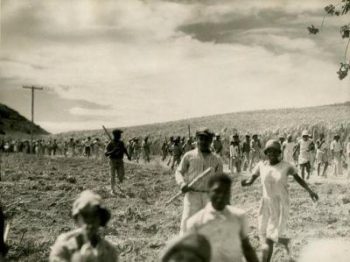 On 19 June, the oil workers declared a stay-in strike demanding higher wages, union recognition, and paid leave / Image: public domain
On 19 June, the oil workers declared a stay-in strike demanding higher wages, union recognition, and paid leave / Image: public domain
Immediately upon hearing the news, workers went on strike and the police were sent to break up the strikes. By 7am, workers at most of the adjacent oil wells were on strike, under the impression Butler had ordered it. In any event, hearing a strike was spreading, Butler headed to them and at 2pm was met with an enthusiastic crowd of workers.
More police were dispatched to break up the strike and another attempt to arrest Butler was made. However, the crowd would not allow his arrest and a plain-clothed police officer was beaten by the crowd before they poured oil over him and burned him to death.
Here we see necessity expressed through accident. The immense pressure on the working class had become too much, and an explosion of class anger burst forward.
Cipriani was out of the country, having been invited to the coronation of King George VI. In his absence, Butler, after the initial spontaneous movement of the workers, called a strike of all oil workers and within two days, a strike had engulfed the oilfields and spread like wildfire.
In the words of Padmore:
“Thousands of East Indian agricultural labourers on the great sugar plantations refused to work. Motor transport in many parts of the country had to stop for want of petrol; ships arriving in the harbour of Port of Spain were unable to discharge their cargoes. The entire economic life of the country was at a standstill.”
The general strike was in full swing and it was to spread rapidly from the south to the north.
The Governor, Sir Murchison Fletcher, who had previously publicly criticised the slave-like conditions on the island quickly changed his tune. He immediately imposed censorship on the press and forbade them to discuss the strikes and the tactics used by the government to defeat them.
Sir Fletcher deployed the police, marines, and volunteers to search for Butler and other strike leaders, which involved rounding up entire villages and carrying out house-to-house searches.
On 21 June, several hundred workers stoned the police at Point Fortin, near Fyzabad, and the following day they set up roadblocks in and out of the strike zone. They attempted to enter the refinery to take control. Three workers were killed and four wounded by police gunfire.
In San Fernando, workers closed down the shops, took control of the electricity station, and attempted to take control of the telephone exchange where two were killed and eight wounded.
The sugarcane workers at Usine, St. Madelaine took over the factory, the trains, the water supply, and electricity. The following day, workers in Port of Spain downed tools and shops were closed too.
A state of emergency was declared and two British warships were rushed to the island from Bermuda, arriving on 22 and 23 June.
Butler remained out of reach of the authorities but placed himself within the reach of the workers so that he could try to guide the strike.
At the same time, Rienzi asked the government for safe conduct for Butler. Governor Fletcher's position was that, until the strike was called off, there could be no talks with Butler. Rienzi promised that he would press Butler to call off the strike.
However, neither Rienzi nor Butler were in a position to call off the strike at that point. The workers were prepared to put up a last-ditch fight to secure an increase in their wages before going back to work.
In a shameful betrayal, Cipriani and the TLP declared their support for the government and, just as in 1919, urged striking workers to use constitutional means to achieve their aims. Under the Crown Colony system, of course, almost 90 percent of the population was deprived of any such means.
The government dug their heels in and, despite the national mobilisation of workers, the strike began to wane under the harassment of the authorities, and it was eventually called off after 14 days.
Movement at an impasse
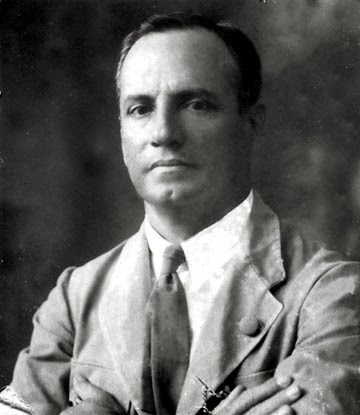 Cipriani and the TLP declared their support for the government / Image: public domain
Cipriani and the TLP declared their support for the government / Image: public domain
The strike had fought back the assaults from the bosses for the moment but, most importantly, the general strike had filled the workers with confidence. For the thousands who took part in the general strike, it had been the first time they had taken matters into their own hands. The rise in class consciousness could not be easily reversed.
A report was produced by the Trinidad Commission, which called Butler a “fanatic Negro” and criticised the police for not firing at unarmed demonstrators, even when they had done so. It also recommended that the unions be brought under the control of the government.
But these restrictions on the unions were not possible to impose, for they would have provoked a further backlash from a newly confident and militant working class.
The ruling class targeted Butler, who was arrested and tried for sedition. During his trial, he used the platform to expose the colonial regime and questioned the authority of the Crown Colony government.
He was sentenced to two years in prison in September 1937 and was even re-arrested when war was declared, finally being released in 1945.
The outbreak of World War II cut across the class struggle in Trinidad and was a convenient excuse for the British authorities to delay publishing the findings of the Moyne Report.
A commission had been put together by the British government to uncover the reasons for the widespread unrest across the British West Indies. In 1944, it published the Moyne Report, which recommended a raft of reforms.
For Trinidad, the most significant reform was the introduction of universal suffrage. However, the ruling class are always looking for ways to keep the working class divided. As such, the introduction of universal suffrage included the clause that it would be for ‘natives’ or English-speakers only, meaning many Indo-Trinidadians who spoke Hindi would not have the right to vote.
The Trinidad Trade Union Council and the West Indian National Party petitioned strongly against this discrimination, stating that Indo-Trinidadians should enjoy equal rights of citizenship just as much as Afro-Trinidadians. Ultimately, this clause was dropped.
Cipriani died in 1945, a year before the first general election under universal suffrage. His death provided an end to a chapter of the class struggle in Trinidad and the beginning of the post-war boom.
The level of class consciousness of the Trinidadian masses remained high after the general strike and throughout WWII. In the 1946 general election, a myriad of left-wing parties put forward candidates.
Most notably, the program of the United Front consisted of three planks including ‘self-government’, nationalisation of basic industries, and universal popular education. With this bold left-wing program, they won 3 out of 9 seats with 37 percent of the vote. The Butler Party won 3 seats with 28 percent of the vote. The Trades Union Congress and Socialist Party won 2 seats with 22 percent of the vote.
The TLP, robbed of their leader and having discredited themselves in the eyes of the working class, failed to win a seat with just 1 percent of the vote.
Need for revolutionary leadership
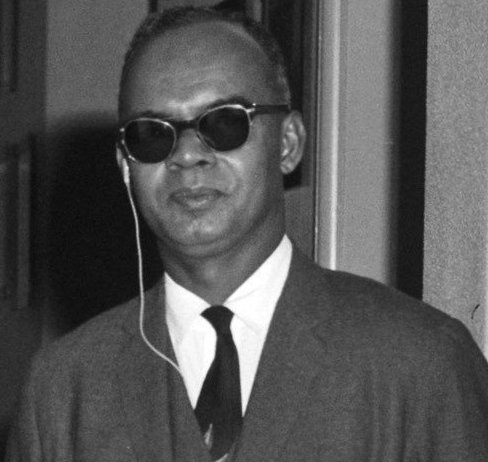 In the 1950s, the workers’ movement came under the leadership of the national ‘progressive’ bourgeoisie, such as Dr Eric Williams / Image: Joop van Bilsen, Wikimedia Commons
In the 1950s, the workers’ movement came under the leadership of the national ‘progressive’ bourgeoisie, such as Dr Eric Williams / Image: Joop van Bilsen, Wikimedia Commons
In the 1950s, the workers’ movement came under the leadership of the national ‘progressive’ bourgeoisie, such as Dr Eric Williams, whose aims were limited to achieving formal independence from British imperialism. Once it was achieved in 1962, the limits of these ‘progressives’ were exposed and in 1970 the working class once again took to the streets against imperialism and capitalism in the Black Power Revolution.
Despite the bold leadership of figures like militant trade unionist George Weekes, the revolution failed to take power from the capitalist class, ultimately, because there was no revolutionary organisation or leadership capable of guiding the revolutionary masses to victory.
The working class are on the move once again in Trinidad and across the world. Inflation, the sharp rise in the cost of living, and the stagnation of wages over the last decade have led to thousands of workers taking strike action. Just in the last year bus drivers, oil workers, teachers, and many other public sectors went out on strike.
The truth is that capitalism can no longer afford reforms and is in a deep crisis in every country. Ahead of the impending convulsive events, the task for revolutionaries is to build the forces of Marxism and the revolutionary leadership required to once and for all overthrow capitalism.
From the Water Riots to the Black Power Revolution, it was a revolutionary leadership and party steeled in the ideas of Marxism that were missing to achieve victory. History has shown us this over and over again. The victory of the working class is only guaranteed if history’s lessons are learned properly by a new generation of revolutionaries.

